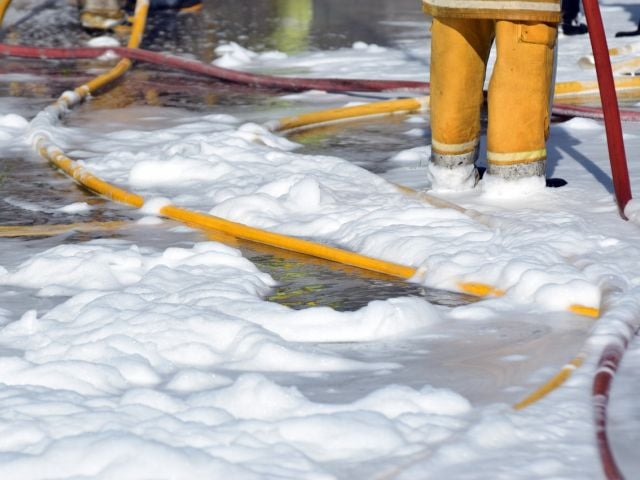
A malfunction unleashed a staggering 51,450 gallons of firefighting foam made with the toxic “forever chemicals” known as PFAS in Brunswick, Maine. It’s the largest accidental spill of such foam in the state’s history, and the sixth-largest in the U.S. in the past 30 years.
A fire suppression system failure on August 19 at the former Brunswick Naval Air Station led to the flood of chemicals. The faulty system was manually deactivated after the foam was released in Hangar 4 from four wall-mounted cannons.
The Maine Department of Environmental Protection, or DEP, is supervising the cleanup, but so far only 6,000 gallons of the foam mixture, called aqueous film-forming foam, or AFFF, have been collected.
PFAS in firefighting foam presents a serious, long-term threat to soil and groundwater. Harpswell Cove, near Brunswick, has faced ongoing concerns about potential contamination. The level of risk depends on how much foam seeps onto properties. The most urgent issue, especially for people using private wells, is the potential for contamination of drinking water.
In the event of a spill such as the one in Brunswick, drinking water must be tested immediately and regularly monitored. Soil tests may also be needed to grasp the extent of contamination.
The PFAS-containing foam stored at Hangar 4 was slated for collection by the Navy this October. Even with the spill and the cleanup now underway, the site stores additional tanks of AFFF.
The incident is yet another stark reminder of the DOD’s slow pace of addressing its stockpile of AFFF. Without swift action by the military, the threat of harm from accidents like the Maine spill will linger.
Switching to PFAS-free foam
For over 50 years, the DOD required the use of AFFF, which led to contamination at over 600 military sites across 50 states.
These foams, used for decades by the military, fire training centers and airports, have exposed firefighters to toxic chemicals and polluted the water supply of service members, their families and surrounding communities. Safer alternatives to PFAS-based foams are available.
In 2019, Congress required the Pentagon to update these standards by January 31, 2023, and stop buying PFAS-based foams by October 1, 2023. Congress demanded a full transition away from the use of these foams by October 1.
In January 2023, the DOD released new requirements for firefighting foam used to put out jet fuel fires, a pivotal step toward the phaseout of foams with toxic PFAS. The specifications require manufacturers to ensure their products contain no intentionally added PFAS and prove they don’t contain PFAS above set limits.
The military’s updated requirements also require that the new foams “pose no serious or high risk to the health of personnel or the environment.”
Many PFAS-free foams meet the international aviation standards used by airports around the world, and several foams meet the Pentagon’s new standards.
Federal Aviation Administration regulations tied to outdated military standards restricted civilian airports from moving to PFAS-free foam, but the new specifications remove this barrier, enabling U.S. airports to make the switch.
In July, the Senate Appropriations Committee approved a transportation spending bill that sets aside $70 million to help airports switch to PFAS-free firefighting foams. The money fully covers the first year of a five-year, $350 million grant program for the foam transition created in May in the FAA reauthorization law.
How PFAS harm health
PFAS are among the most persistent compounds known, contaminating everything from drinking water to food, packaging and personal care products. These chemicals accumulate in the body and don't break down in the environment.
Even at very low levels, PFAS in drinking water have been linked to serious health issues, including immune system suppression, reduced vaccine effectiveness, and an increased risk of certain cancers. Other associated risks include elevated cholesterol, reproductive and developmental problems, and other long-term health harms.
PFAS pollution affects more than 130 million Americans, with government test data confirming the chemicals have tainted the water supply at 7,457 locations across the U.S. But the problem could be even larger. In 2020, EWG scientists estimated that more than 200 million Americans may be drinking water contaminated with PFAS at 1 part per trillion or higher.
An ongoing contamination crisis
In April, the EPA took the landmark step of setting first-time limits for six PFAS in drinking water. The EPA and other agencies have also taken a number of vital actions targeting PFAS contamination, but much more work remains to be done.
EWG in August proposed a comprehensive plan for policies and funding increases the next presidential administration should pursue to tackle PFAS contamination. The agenda includes key roles for the EPA, the Food and Drug Administration, and the DOD, among other agencies.
Maine’s recent laws limiting the use of PFAS-containing firefighting foam failed to prevent the massive spill. It’s a sober reminder of the work needed to confront the PFAS crisis. The DOD must pick up the pace, because only swift decisive action will prevent future environmental and public health disasters.



